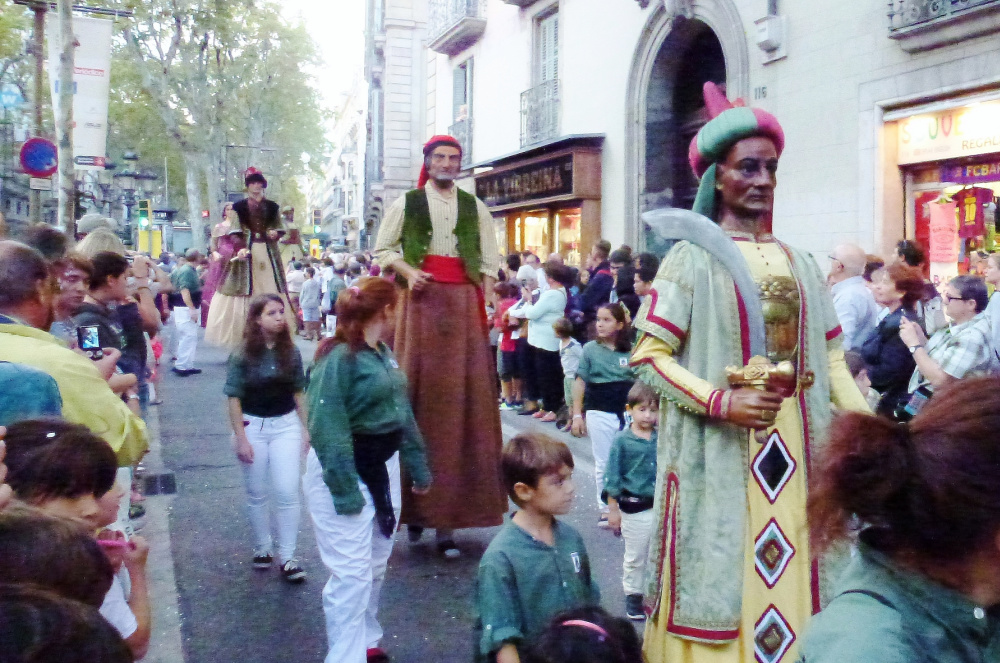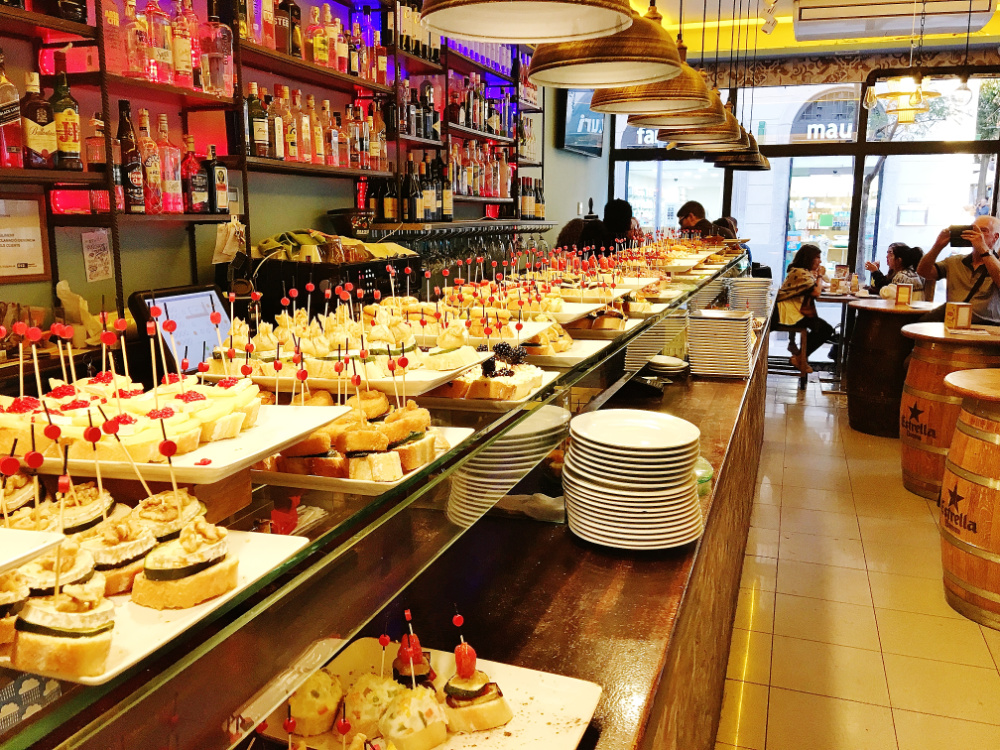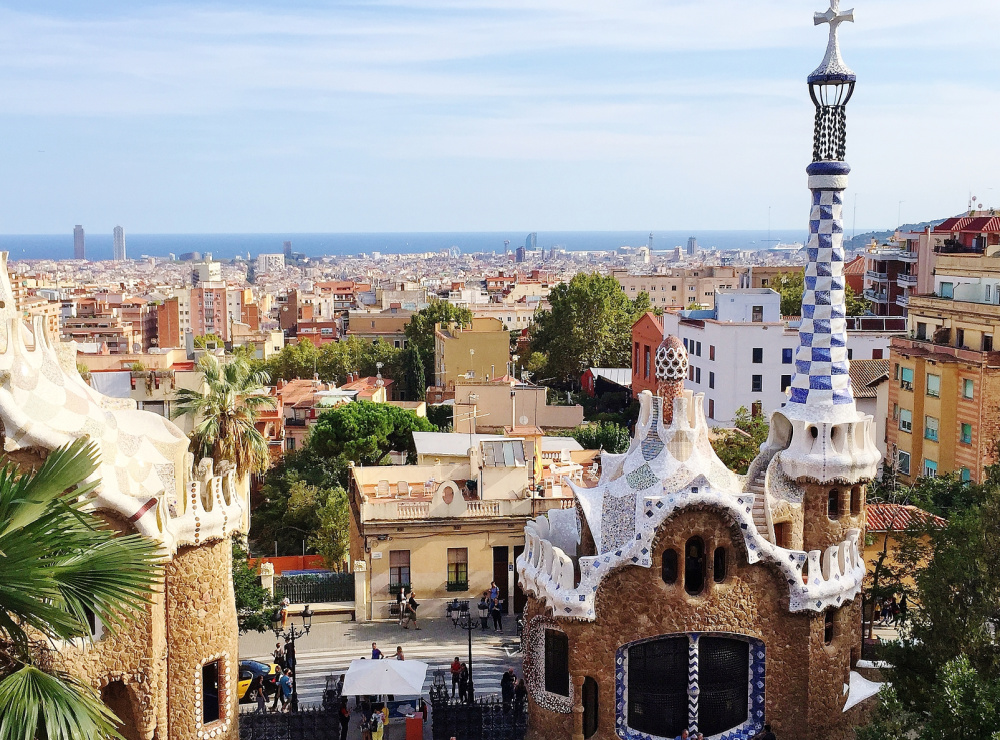
Famous for its architecture, examples of Barcelona’s Modernista (Art Nouveau) style make a big impression on visitors to this city. It’s also blessed with quirky monuments, a vibrant art scene, good beaches, and many good restaurants and tapas bars, which we made sure to try. But a week here only scratched the surface of such rich tourist offerings – despite our best efforts to see it all. We also spent a couple of days here during two Mediterranean cruises, so we were able to explore a little more. To condense it all into a single blog would be impossible, so here is a simplified version in no particular order.
The last week in September marks the arrival of La Mercè festival, which honours the Virgin of Grace (Mare de Déu de la Mercè) in gratitude for her protection of the city as Patron Saint. Cultural and artistic presentations are held throughout the city, including the Parade of Giants, fireworks, traditional dances, circus acts, bands, comedy and dramatic shows. We were lucky to be there in time for the Grand Parade along the length of La Rambla, Barcelona’s popular tourist thoroughfare, which extends from Plaça Catalunya to Barceloneta. The participants in the parade included drummers, pipers, dancers, a horse band, district social club members, as well as the Giants made out of papier maché, towering above the spectators and carried by individuals within a wooden framework inside the costume. But if you can’t time your visit with a fiesta you can still watch the passing parade along La Rambla, any day!

The beach at Barceloneta is wide and long, full of restaurants, nightclubs and beach bars. It is the easiest strip of beach to access, via the metro. It extends from the huge W Hotel, looking like a ship’s sail, north to Frank Gehry’s Peix d’Or (Golden Fish) at Port Olimpic. Despite it being the end of the beach season, we found the sand densely thronged with sunbathers as it is the beach most commonly used by tourists. A paved boardwalk provides access all along the beach.
The Mercat de Sant Josep de la Boqueria is a large public market in the Ciutat Vella district of Barcelona, with its grand iron entrance on La Rambla, not far from the Liceu metro stop. The centre of the market is arranged in an oval pattern with the seafood section, spreading out to stalls selling mainly meats and charcuterie on one side and fruits and vegetables on the other, interspersed with nuts, olives, cheeses and sweets. The colour, smells and vibrancy of the stalls, the bustle of shoppers and cries of the vendors is what makes the visit so engaging, as is stopping for a bite at one of the many tapas bars that dot the market.
This hill to the southwest of the city centre gives a commanding view over Barcelona and its harbour immediately below. Access to the top of the hill can be gained by road, funicular railway and gondola, or even an aerial tramway from the port. At the top of the hill (a height of 184.8 m) is a pleasant park with the remains of the 17th century Castle of Montjuïc open to visitors. The area also boasts the grand Palau Nacional which houses the Museu Nacional d’Art de Catalunya, the Estadi Olímpic (the Olympic stadium), and the ornate Font Màgica fountain. This park made a great place for us to relax away from our hectic sightseeing of the city below.
The Poble Espanyol de Montjuïc was built in 1929 for the Barcelona International Exhibition as a model of a Spanish village that would represent all the characteristics of villages throughout the country. Buildings, streets and squares from all around Spain were reproduced to scale. It was so successful that after the exhibition closed, the village was retained and is now one of Barcelona’s top tourist spots. It has become a unique shopping centre, proving work spaces for artisans who display and sell their handcrafts as well as exhibitions of contemporary art. Here is also a variety of restaurants and bars as well as shops that sell regional gourmet foods. At night there are often concerts or wine tastings. For us, the El Tablao de Carmen, located in the area dedicated to Andalusia, was the place to enjoy dinner and the vibrant Flamenco show, considered the best flamenco show in Barcelona.
How could you visit Barcelona and not embrace the food scene? A large portion of our time here was spent dreaming of what we might eat next and searching out the places to find it. The custom is to eat tapas at a number of bars with pre-dinner drinks from about 9pm and then move on to a restaurant afterwards. We found that the wonderful array of tapas meant that very rarely did we have a restaurant-type meal like we would at home. And if we did eat a meal it was basically a selection of raciones or shared plates such as anchovies, padrone peppers, stuffed eggplant with cheese on top, tiny bread sticks spread with fresh tomato purée, and of course the wonderful Ibérico ham! The next night it was patatas bravas, ham and chicken croquetitos, bacalá-stuffed potatoes with sauce brandade, and pulpo (octopus) a feira – very tender and spicy. Each tapa has a colour-coded toothpick, which is how they calculate the bill. The area of El Poble-Sec, west of La Rambla and not far from the port, is where every second business seems to be a tapas bar. If you bar-hop through there you cannot go wrong!

Naturally, you cannot visit Barcelona without paying homage to the modernista architecture that dots the city, epitomised by the famous basilica La Sagrada Familia (the Holy Family), Antoni Gaudí’s most celebrated work. Begun in 1882 under a predecessor, the project was taken over and redesigned in 1883 by Gaudí. Following his death in 1926, Gaudí’s body was laid to rest in a crypt within the basilica. It is not expected to be finished until 2026, the centenary of his death. However the basilica has been consecrated already and so can be used for masses. It is the most popular tourist attraction in Barcelona, which fortunately provides income for its continued construction. One of the best viewpoints is from a park to the north-east. Gaudí drew his inspirations from nature as well as devising various abstract shapes not used on churches before. As the sun shines through the stained glass windows as it moves during the course of the day, it illuminates the interior with the most beautiful colours.
At the top of a steep hill which affords wonderful views of Barcelona below, is Parc Güell. This park, also designed by architect Antoni Gaudí, was built between 1900 and 1914 but was not officially opened as a public park until 1926. The house where he lived is now a museum containing interesting furniture also designed by Gaudí. Part of the complex is a municipal garden which has free entry. The park contains amazing stone structures, such as the terrace walls which resemble the trees above, stunning tiling and fascinating buildings. The Gaudí dragon (or salamander) fountain on the stairway to the terrace is adorned in beautiful coloured tiling, as are various pinnacles on building rooftops and the ceiling mosaics under the terrace. The monumental zone is arranged around a large central square bordered by a snaking, mosaic-covered bench. However this zone is subject to charge and there is a quota of 400 tourists allowed entry per half hour. It pays to book online to get a timed entry ticket.

The Gothic Quarter is the centre of the old city of Barcelona. Some of the streets here are so narrow that traffic is forbidden entry. Many of the buildings date from medieval times, some from as far back as the Roman settlement of Barcelona, such as the walls near the cathedral. However a massive restoration project was undertaken during the early twentieth century which means that several of the notable examples of architecture are not entirely Gothic. The majority of the cathedral of St Eulàlia, however, was constructed in the 14th century. Unusually, it has a cloister where 13 white geese are kept, 13 being the age of Saint Eulàlia when she was martyred.
Admire the artistry in the Picasso Museum – Getting in took us three attempts! First – it is not open Mondays. Second, although you can book online, we didn’t, and soon discovered there was a quota on admissions and we missed the cut after standing in line outside for a while. The third attempt was successful despite a very long wait and a strictly-timed entry. Housed in five former medieval palaces, the collection mainly centres on Picasso’s early works up to and including his Blue Period – particularly those completed during his years in Barcelona. The permanent collection is organized into three sections: painting and drawing, engraving, and ceramics. There is also a special exhibitions space and a library containing publications documenting Picasso’s life and works.
Barcelona is a city I had been longing to visit, but a week followed by several day trips was hardly enough. There were so many places to see and experiences to be had. We tried to cram it all in – along with exploring the hinterland by car and coach, and catching a train to Girona in the north, so the beyond Barcelona stories are still to come!